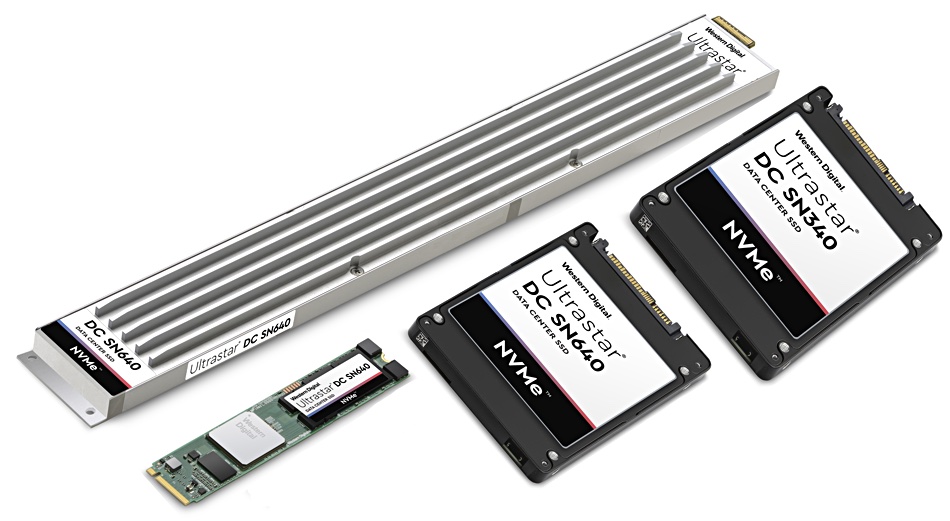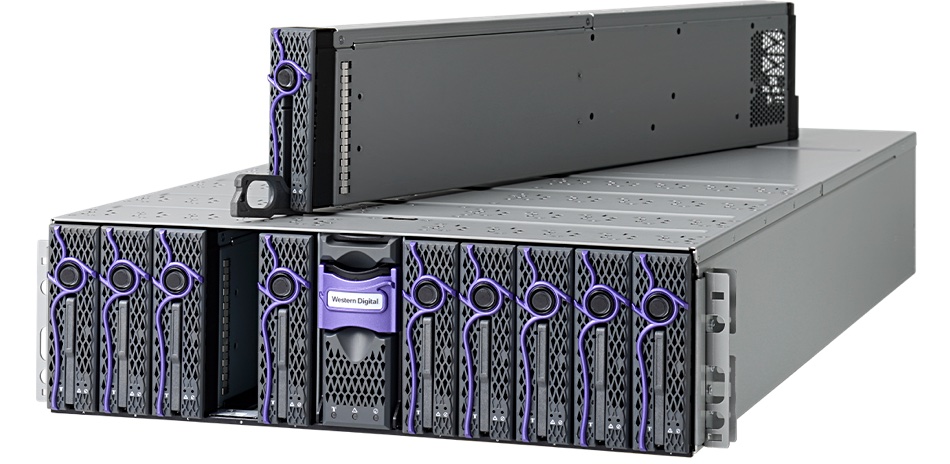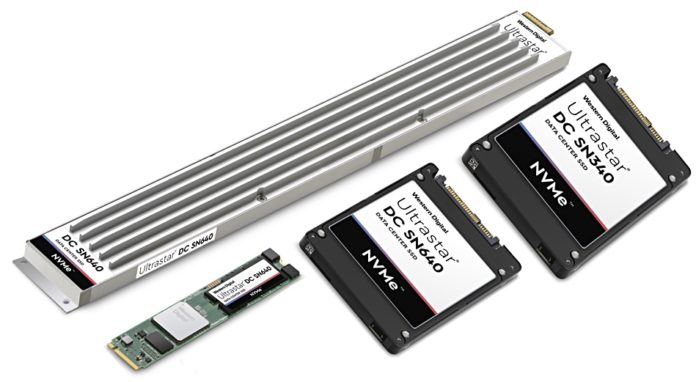Western Digital has refreshed its NVMe SSD, composability and storage server products.
The company has added 96-layer 3D NAND data centre drives, almost quadrupling maximum capacity compared to a prior generation with a new ruler format. It has replaced the composable systems F3000 flash drive (aka proprietary SSD) offerings with a similarly specced F3100 drive.
And it has set up a compatibility lab for composable systems and their multi-sourced components. Finally it has added new storage server boxes to the Ultrastar Serv line for OEMs and resellers.
Ultrastar SN640 and SN340
WS has upgraded the Ultrastar DC SN630 drive, a 64-layer 3D NAND TLC (3 bits/cell) product, to the mixed-use SN640 with added M.2 and ruler formats, and the SN340 read-intensive drive. Both use denser 96-layer 3D NAND organised as TLC flash.
The SN640 comes in three formats:
- M.2 with 960GB, 1.92TB and 3.84TB capacities,
- U.2 with 960GB, 1.92TB, 3.84TB and 7.68TB capacities,
- EDSFF E1.L with 7.68TB, 15.36TB and 30.72TB capacity levels.

The SN630 topped out at 7.68TB in its U.2-only format.
According to a product brief the performance data for these three drives is up to 3.0/2.0 Gib/sec for sequential reads and writes. The Random read/write IOPS numbers are up to 480,000/2120,000. WD has not revealed the performance numbers for each format type.
It does say in its release that the EDSFF format drive is designed to provide speeds up to 720,000 random read IOPS.
SN640 capacity can be tuned to increase endurance from 0.8 drive writes/day to 2 DWPD. So a 1.92 drive with an 0.8DWPD rating can be increased to 2DWPD by setting the capacity down to 1.6TB.
The SN640 controller features NVMe multi-namespace support, up to 128 of them, and management for zoned drive support.
The drives have Instant secure erase and AES-256-bit encryption. They are sample shipping to potential customers.
SN340
This is a read-optimised drive with 3.84TB or 7.68TB of capacity. Performance is skewed heavily to read work, achieving random read and write IOPS up to 420,000 and just 7,000. Sequential read and write bandwidth is similarly skewed; up to 3.1GiB/s and 1.4GiB/s.
The drive supports just 0.3 DWPD for random writes but up to to 1.2DWPD if all the writes are 32KB-aligned. The SN340 draws 6.5W when operating -better then the prior SN630 read-intensive drive which drew 10.75W.
OpenFlex F3100
Western Digital has refreshed OpenFlex with an F3100 flash drive replacing last year’s F3000. Both are NVMe-over-Fabrics-connected ruler-like format drives, like a longer version of a 3.5-inch drive as an illustration of the device on an E3000 chassis makes clear:

OpenFlex products are part of WD’s composable systems infrastructure, whereby compute, storage and networking are disaggregated from fixed configuration servers and placed in resource pools. From there, portions can be dynamically composed or configured into server systems for particular workloads.
WD is competing with vendors such as Dell EMC, DriveScale, HPE and Liqid in the composable systems market.
The OpenFlex F3100 holds 61TB, like the F3000 and does up to 11.7GB/sec. The F3000 was rated by WD at 12GB/sec; the same within decimal rounding limits. The F3100 is said to deliver up to 2.1m IOPS with a latency of less than 48μs, making it the fastest NVMe-oF open composable storage platform, WD claims.
Our working assumption is that WD’s F3100 is a sped-up F3000 – we have no IOPS and latency numbers for the prior F3000. We don’t have any information about the type of flash in the F3100 or how it is organised to make a 61TB device.
Blocks & Files notes the SN640 EDSFF ruler drive holds up to 30.7TB and it is tempting to think of the F3100, with its 61TB capacity, as a pair of SN640 rulers in a single case.
Composable Compliance Lab
WD has also set up a compliance lab, along with partners, for its composable system. It calls this an open composable ecosystem, as away of contrasting the competition – which includes Dell EMC, HPE and Liqid.
The lab will test and validate end-to-end interoperability between OpenFlex components, using the Open Composability API for example, from different suppliers, such as Broadcom, DriveScale, Edeticom. Kaminario, Mellanox and Xilinx.
Storage servers
WD has added new Serv24 storage servers, intended as building blocks for software-defined storage (SDS), hyperconverged infrastructure (HCI) and edge environments. Edge encompasses remote and branch offices, video surveillance, and IoT edge environments.
The Serv24-4N is a 4-node, all-flash, NVMe drive system for HCI use with a 2U chassis. Each node has two Xeon SP CPUs, 24 PCIe lanes to six SSDs, and 3 x 16 lane PCIe slots. The maximum raw capacity is 184TB.
The Serv24+6 is a hybrid flash and disk system inside a 2U chassis, slated for SDS and edge use. It has 24 front-mounted drive bays and 4 disk drive bays in the rear. Disks can use SAS or SATA interfaces. The maximum capacity is 420TB.
Western Digital’s release says the Serv24+6 also has “up to six NVMe SSDs in the rear bays for a data-acceleration tier to improve application performance.”
These two join the Serve24 24-slot NVMe drive system, a Serve24 high-availability system and a Serv60+8 hybrid flash and disk server in a 4U cabinet.
More information and availability
Get an F3100 datasheet here. You can download an SN340 and SN640 product briefs. The DC SN640 and 340 are sample shipping to prospective customers.
Read a Western Digital composable systems blog for additional information.
The Ultrastar Serv24-4N will be available this quarter. The Ultrastar Serv24+6 is sampling now and will be available in volume by September. There is no product brief or datasheet information available for either one of these systems.








